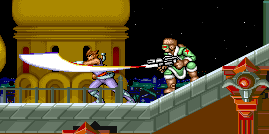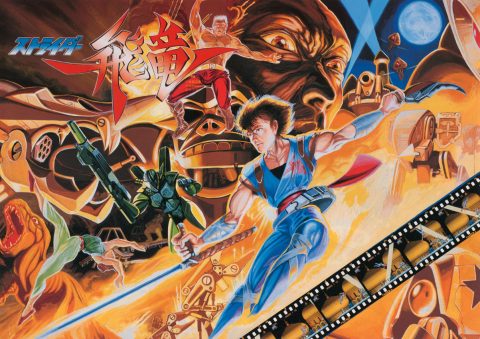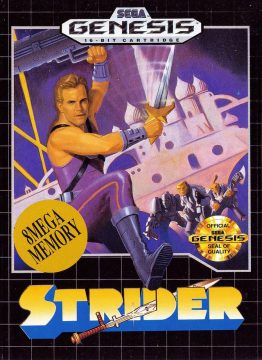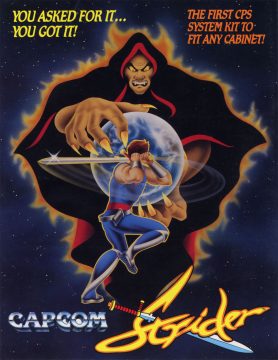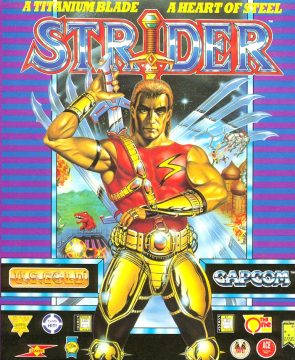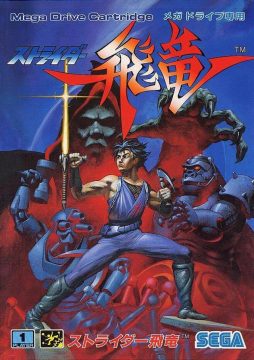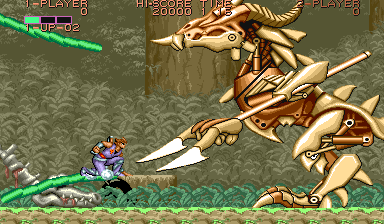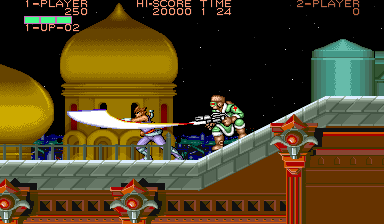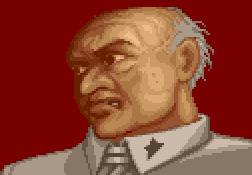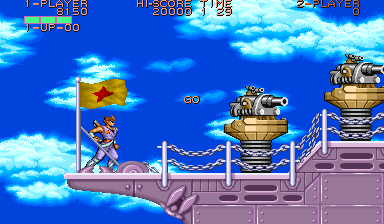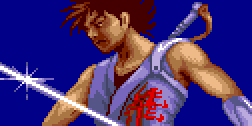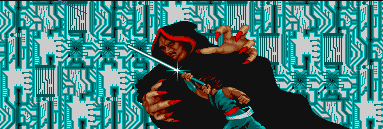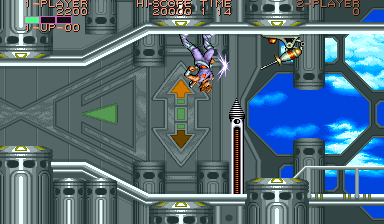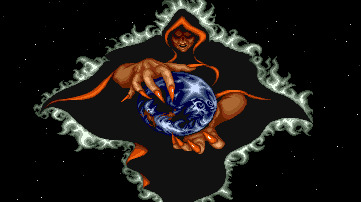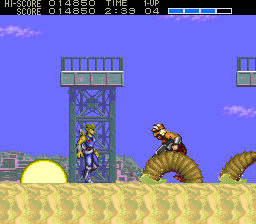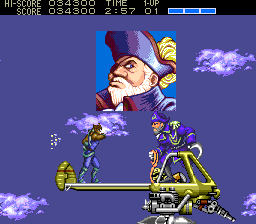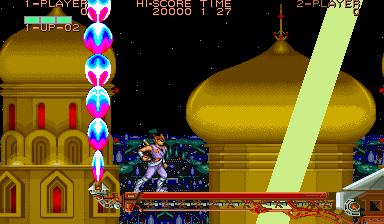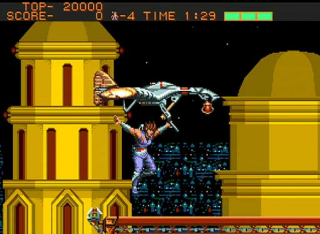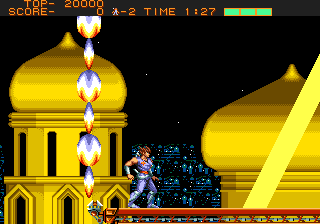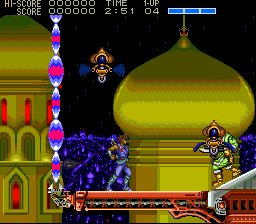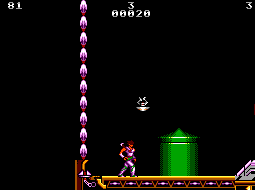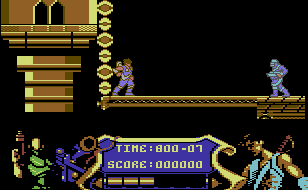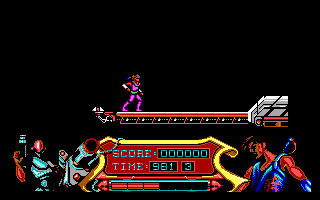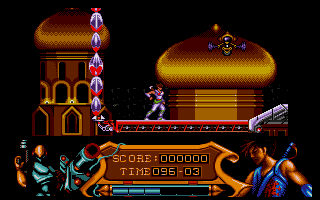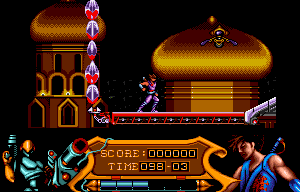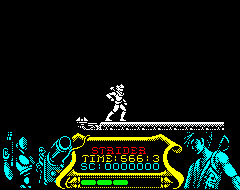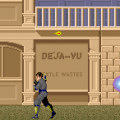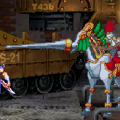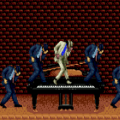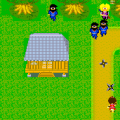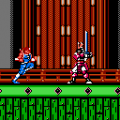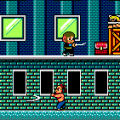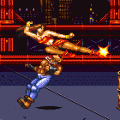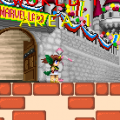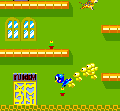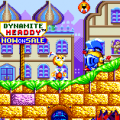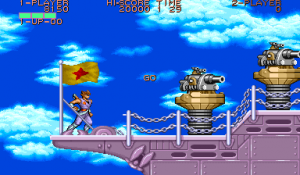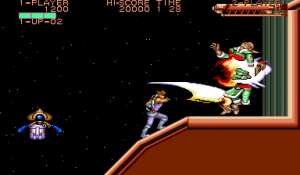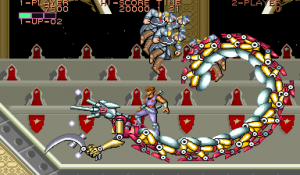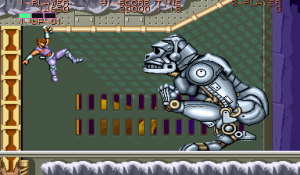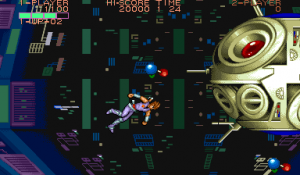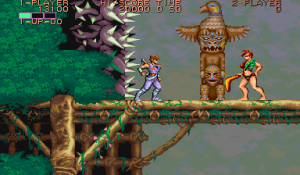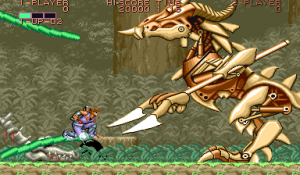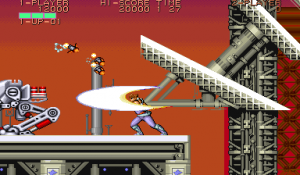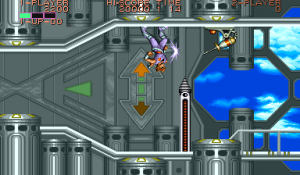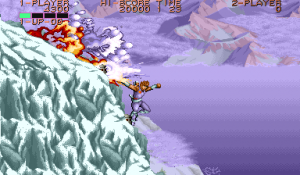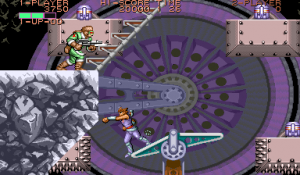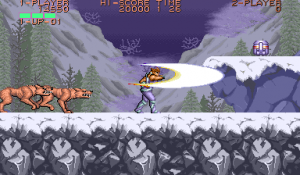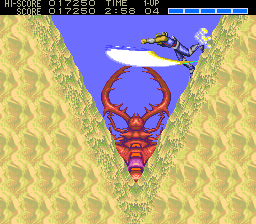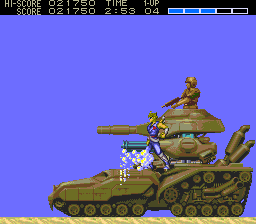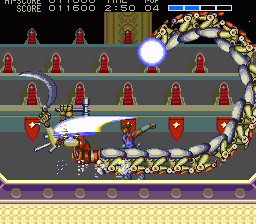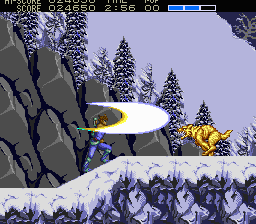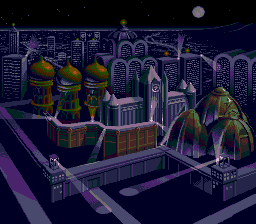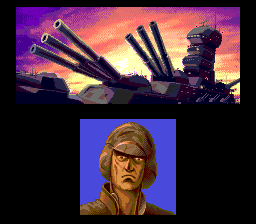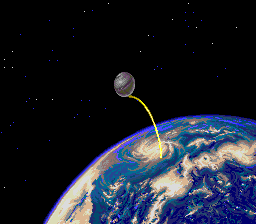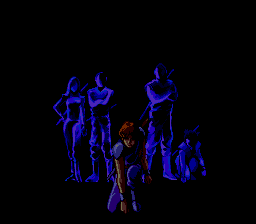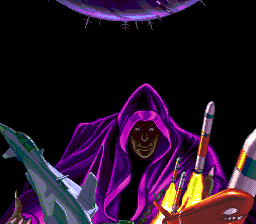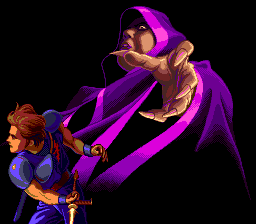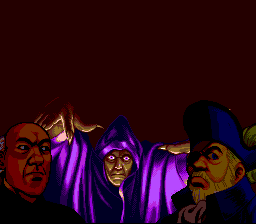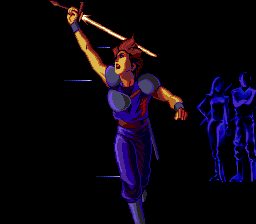Capcom’s Strider series is set in the future, a time of the Striders, an elite group of counter-terrorists working to fight the evils of the world. The series chronicles the adventures of Hiryu, the greatest of all the Striders, who traverses the land with his cypher, Falchion. Cyphers are the standard issue weapons for Striders, which are the child of a tonfa stick and a light-saber. While Hiryu is skilled with his weapon and he’s extremely acrobatic, he faces many antagonists, ranging from mechanical gorillas to reanimated mastodons.
Strider was initially conceived as a multimedia project, with an arcade game, a Famicom / NES game, and a manga published around the same time. While the arcade game has little to do with the manga, the storyline of the NES game ties in directly with it. The proposed name for the English version was “Falcon”. The arcade game was directed by Kouichi “Isuke” Yotsui.
All appearances of Strider Hiryu credit “Moto Kikaku” as the character designer. Moto Kikaku is not the name of a specific person, but rather a group of artists that share the copyright. While Hiryu wears a flowing red mask in the original artwork and in cutscenes, he’s never actually shown wearing it during gameplay, at least not until his appearances in Marvel vs. Capcom and Strider 2.
The original arcade game takes place in the distant future. A small European nation known as Kafazu (a misromanization of Kazakh) is ravaged and obliterated by a mysterious army. This army then goes on to take out all of Europe and several other continents before their leader is revealed, an enigmatic figure known as Grandmaster Meio (who bears a suspicious resemblance to Emperor Palpatine). Hiryu is called upon to perform the task of reaching and terminating Meio.
This makes a concealed fact rather obvious – like the Badds in Bionic Commando who were really supposed to be the Nazis, Kafazu is a futuristic version of Russia, making Strider a Cold War-themed game. It seems ironic that the Berlin Wall was taken down the same year as Strider was released.
Hiryu’s voyage begins in Kafazu, the city where the chaos all began. He rides in on his glider, then jumps off as an alarm sounds, and suddenly the whole Kafazu army is after him. The action starts right away, with soldiers rushing the hero, but they’re not that skilled. Hiryu, on the other hand, swings his cypher extremely quickly. Players with itchy trigger fingers can cackle with glee as they move through the poor schmucks, slicing their torsos clean in half. Beyond Kafazu is the brutal icy hell of Siberia, the perilous airborne battleship Balrog, the savage fury of the Amazon jungle, and finally, Meio’s main base of operations, the Third Moon.
Possibly the most impressive stage is the third one, the battleship Balrog. After tearing through a turret that provides an entry point for Hiryu, he has to navigate his way through many platforms revolving on conveyor belts, climb up a pair of moving walls before he gets squished, deal with an improbability of physics when the ship changes gravity, destroy the ship’s core, (which is apparently responsible for switching the gravity) and then hightail it out onto an escape ship to not go down with the exploding Balrog. This was beyond impressive for 1989, and it still manages to hold up today.
The Amazon level is also extremely well done. It’s filled with vines, which adhere to weird physics as they flip and jounce about, launching Hiryu all over the place. Then he gets to ride on dinosaurs. The finale, the Third Moon, combines elements and enemies from the previous four stages to make a difficult final challenge. If Hiryu can pass all that, he is granted an audience with Meio for the final battle.
Strider only has five levels, but each of them are considerably lengthy. What’s even better about these stages are the impressive environments. For 1989, and for the CPS1 system, this game had a lot of visual appeal.
Hiryu himself is nicely animated, as is every enemy sprite, all of which contain many frames of animation. There are some impressive environments for the time, and they really helped bring gamers into a whole new world. For example, Hiryu has to slide under spikes and climb a big spire before jumping down the other side in the first stage. In Siberia, he has to work his way around platforms on gigantic moving gears. After a battle with one of the mid-bosses, he has to run down a huge icy mountain, quickly gaining speed on his descent, and the player has to time the jump to avoid plunging off the bottom of the screen.
In between the stages are cutscenes that mostly consist of Meio taunting Hiryu and the hero learning about Meio’s evil plans. These cutscenes have digitized voices, and the characters speak in different languages. Meio and his henchman, the bounty hunter Solo, speak English, Hiryu speaks Japanese, Meio’s other henchman speaks Russian, and so on.
From regular human soldiers, to ravenous wolves, to robots bearing a strong resemblance to Robocop‘s ED-209, to Amazon women, the young Strider has a diverse cast to face off against. The bosses are nothing short of astonishing, and new players could take many continues to finally beat them. The first boss, Ouroboros, represents a big hurdle. In a room with enemy officers sitting down in chairs, the commander, who stands in front of his troops, gives a signal, jumps into the air, and one by one, each officer jumps right in and transforms into a section of the entire boss! The end result is a giant mechanical centipede with two arms, wielding a hammer and sickle. Ouroboros then roves all about the room, shooting bullets from its mouth. Hiryu has to ride on its back and slash away at its head to defeat the beast.
Other bosses include Mecha Pon, the giant mechanical gorilla, the aforementioned bounty hunter Solo (who despite being named after Han Solo seems inspired by Boba Fett) that Hiryu has to fight before running down the icy mountain in Siberia, the Kuniang M.A. Team (a trio of Chinese female martial artists), the core of the battleship Balrog, Captain Beard, the owner of Balrog (and definitely the weakest boss in this game), the huge mechanical T-Rex Lago (in contrast to Beard, the hardest boss) – and they have to be faced all over again in the Third Moon before the final battle.
The controls are tight and easy to learn. Hiryu can scale any of the walls and ceilings thanks to the assistance of a grappling hook. Holding the hook in one hand cuts down on his speed to swing Falchion, but man was not meant to both climb and fight on walls.
At least he still can defend himself. Holding Down while pressing the Jump button allows Hiryu to slide under any dangers that may befall him, and he can still use the Falchion, even in mid-slide. He can’t change directions while jumping, but he can attack in midair, and he makes a nice somersault when jumping left or right. An interesting aspect of physics here is that he moves slowly up steep inclines, but speeds up when going down. He can also jump farther if he’s moving fast.
Still, Strider cannot be mastered overnight. The dense enemy forces, combined with the fact that Hiryu can only take three hits before dying (with a cool death animation and sound effect – he seemingly teleports away) make the challenge of this game pretty high nonetheless. Thankfully, Hiryu has some power-ups to help him, which include a cypher extension, max health expansions, robot helpers that fire energy rings, a robot hawk, and a mechanical panther that tears through most enemies in just a single attack.
The sound and the music is also excellent. The Falchion makes a nice clean “SHING!” effect each time it slices through the air. The explosions sound muddled, but there are other great effects, such as clanging steel, sirens, and the chatter of the Amazon women in stage four. The music also changes constantly – the first stage has five different pieces of music alone, alternating between atmospheric and dramatic.
The luscious graphics, the powerful sound, the fluid mechanics, the astounding enemies – Strider is a fantastic game, evidence that Capcom was one of the best of the era.
There are but minor discrepancies between the Japanese and America/European versions. The Japanese game is called Strider Hiryu, while it is shortened to just Strider for the rest of the world (although the kanji is still in the logo). The Japanese versions also have voice samples of Hiryu yelling when he slashes his sword, which are absent from all other versions.
Strider naturally saw several ports to home systems and computers. One of the best is the X68000 version, which is practically arcade perfect, outside of some minor missing details.
The most popular is the Genesis version, developed and published by Sega. While certain concessions had to be made – the color palette was slightly reduced, some background scrolling eliminated, all of the cutscene voices removed, and a solid black bar was put over the status bar – it otherwise looks and plays very close to the arcade. This version appears on the Wii Virtual Console. For some reason, the iconic Russian-style domes in the first level have been redrawn.
The Sega Master System port, unreleased in Japan, needed to be scaled down, and it’s a terrible port. It’s choppy, and it slows down horribly every time Hiryu slashes his sword, making it very hard to enjoy.
The PC Engine also saw a release of Strider Hiryu in Japan, ported by NEC Avenue. It’s one of the few games that requires the Arcade Card, but in spite of the extra RAM, this version didn’t turn out quite as well. The visuals are worse than the Genesis version, nearly all of the multi plane scrolling was removed, and there’s quite a bit of flicker.
There are, however, some minor additions. Every level has a cutscene with different art and voices than the arcade version, plus boss characters give short speeches, complete with portraits, before each fight. All of the music has been remixed in redbook audio, as well. The biggest addition is an entirely new level. Right after the first stage, Hiryu runs through the desert, fighting against antlions, sandworms and tanks – it shares the same exuberant creativity as the rest of the game.
Strider was also ported to the PlayStation and included along with Strider 2 on a separate disc (although a printing error in the North American release mislabeled the two). It’s almost arcade perfect, but the music sounds a little off. Capcom included an “arranged” version that upgrades the synth beyond FM bleeps, but the choice of instruments is terrible, and it sounds pretty bad.
The computer ports were all handled by Tiertex, all of which have a status bar that takes up a large chunk of the screen. The 8-bit computer ports are simplified, with less enemies and redesigned stages. The ZX Spectrum and Amstrad CPC versions are similar, though the former has black and white graphics and runs smoothly, while the latter has simple colors and runs poorly. The Commodore 64 version looks better but runs slowly. It’s also missing some bosses – rather than facing off against Ouroboros at the end of the first stage, you destroy the laser turret before you descend into the lair and the level ends.
The IBM PC version is another slight step up graphically, though still confined to 16 colors, with terrible sound. The Amiga and Atari ST versions are the best of the lot, with the best color and actual backgrounds, whereas the others remove them almost entirely. All of the computer versions with sound cut out most of the music – the Amiga one sounds the best. The 16-bit computer ports are playable, but they’re a little slow and choppy, and pale vastly compared to the Genesis port.
There are different endings in the various ports. In the arcade version, Hiryu jumps on a whale and rides off while the credits roll. In the Genesis version, Hiryu views the destruction of the fortress, then takes off on his hang glider. In the computer ports and the SMS version, there’s a text scroll starting that the “simulation” has been completed, implying that the game was just a virtual reality training exercise.
Emulations of the arcade version are also found on Capcom Classics Collection Volume 2 for the PlayStation 2 and Xbox, and Capcom Classics Collection Remixed for the PSP. These are no frills collections, with no support for true low-res on the console versions.
